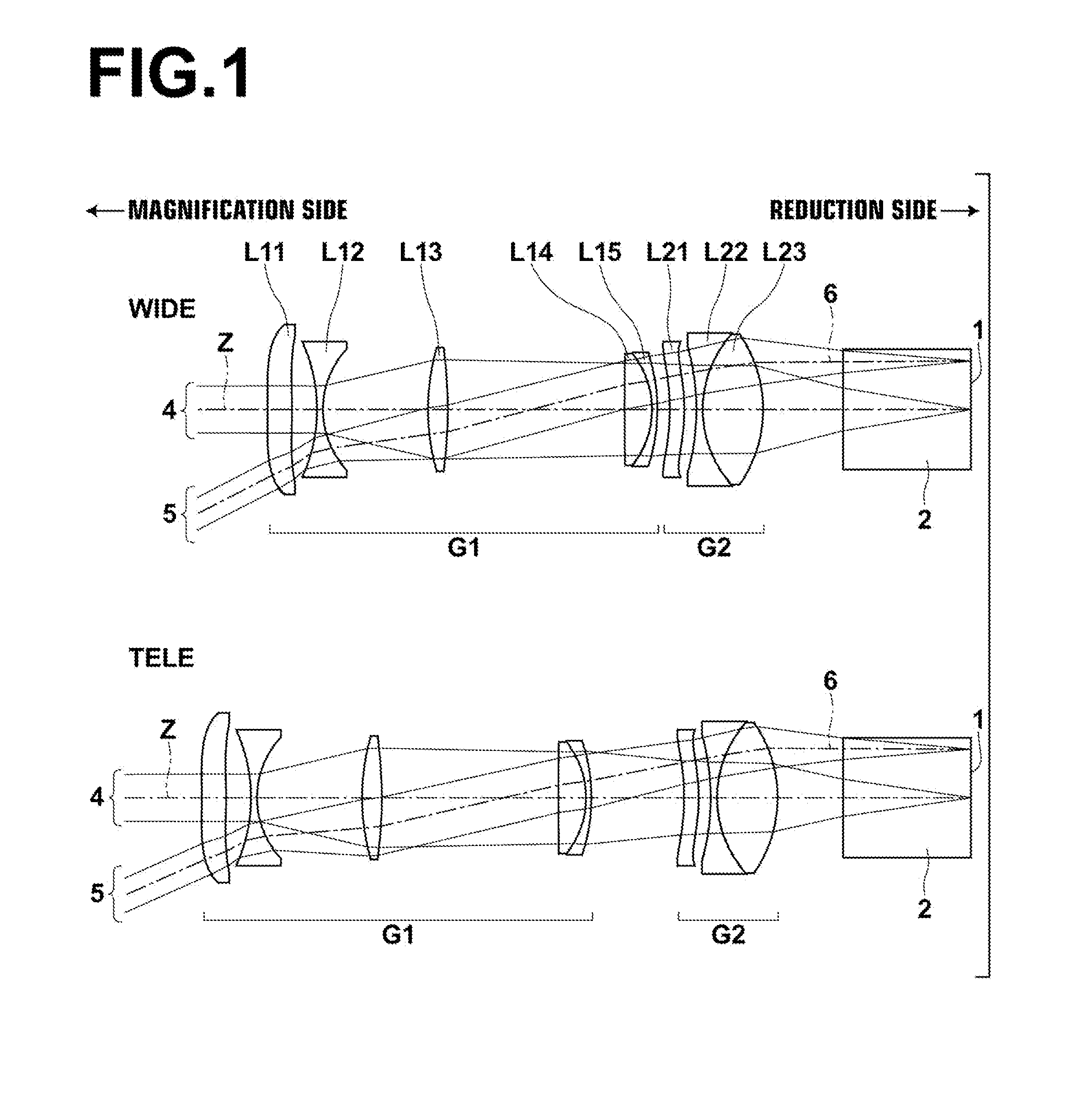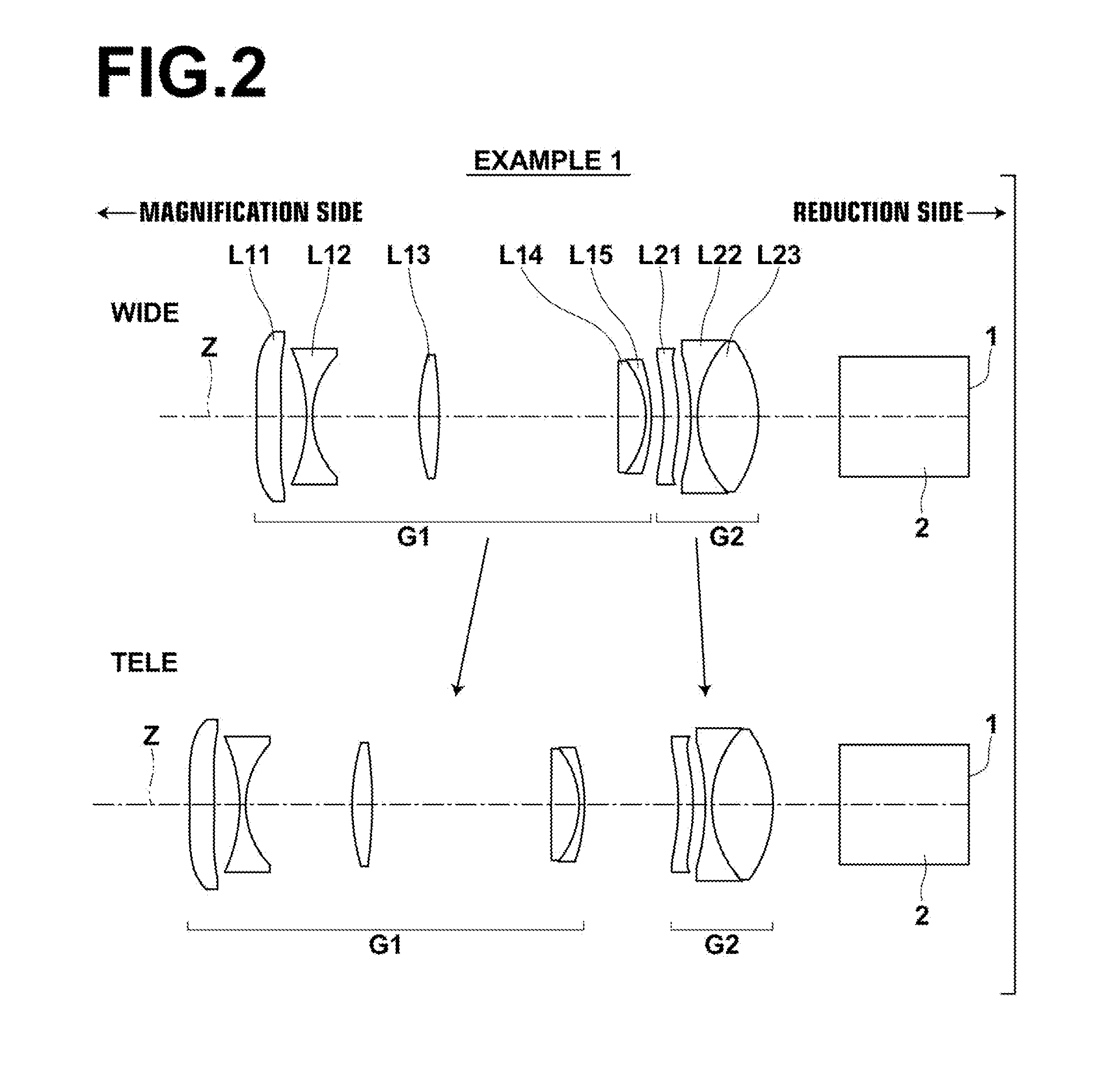Variable magnification projection optical system and projection display apparatus
- Summary
- Abstract
- Description
- Claims
- Application Information
AI Technical Summary
Benefits of technology
Problems solved by technology
Method used
Image
Examples
example 1
[0086]FIG. 1 illustrates the lens configuration of a variable magnification projection optical system of Example 1. In FIG. 1, the upper side diagram with a sign “WIDE” attached thereto illustrates the lens configuration of each lens group at the wide angle end while the lower side diagram with a sign “TELE” attached thereto illustrates the lens configuration of each lens group at the telephoto end.
[0087]The variable magnification projection optical system of Example 1 is of a two group configuration in which a first lens group G1 having a positive refractive power and a second lens group G2 having a positive refractive power are disposed in order from the magnification side, and the reduction side is made telecentric. The first lens group G1 is moved to the magnification side and the second lens group G2 is moved to the reduction side during the magnification change from the wide angle end to the telephoto end. FIG. 2 schematically illustrates the movement directions of the two len...
example 2
[0104]FIG. 3 illustrates the lens configuration of a variable magnification projection optical system of Example 2. The variable magnification projection optical system of Example 2 has an almost identical configuration to that of Example 1, but differs in that the lens L14 is a positive meniscus lens with a convex shape on the reduction side. Note that the variable magnification projection optical system of Example 2 is configured such that the focusing when the projection distance is changed is performed by moving the first lens group G1.
[0105]Tables 4, 5, and 6 respectively show basic lens data, variable surface distances, and aspherical surface coefficients of the variable magnification projection optical system of Example 2. A to L of FIG. 7 show each aberration diagram of the variable magnification projection optical system of Example 2.
TABLE 4Example 2 Basic Lens Data (Focal Lengths = 1.00 to 1.10 to 1.15)SiRiDiNdjνdj 1*−11.5620.2791.491057.58 2*−6.9160.2503−1.7730.0631.53174...
example 3
[0106]FIG. 4 illustrates the lens configuration of a variable magnification projection optical system of Example 3. The variable magnification projection optical system of Example 3 has an almost identical configuration to that of Example 1, but differs in that the lens L11 has a biconcave shape in the paraxial region, the lens L14 is a negative meniscus lens with a convex surface on the magnification side, the lens L15 is a biconvex lens, and the lens L14 and the lens L15 are not cemented. Note that the variable magnification projection optical system of Example 3 is configured such that the focusing when the projection distance is changed is performed by moving the second lens group G2.
[0107]Tables 7, 8, and 9 respectively show basic lens data, variable surface distances, and aspherical surface coefficients of the variable magnification projection optical system of Example 3. A to L of FIG. 8 show each aberration diagram of the variable magnification projection optical system of E...
PUM
 Login to View More
Login to View More Abstract
Description
Claims
Application Information
 Login to View More
Login to View More - R&D
- Intellectual Property
- Life Sciences
- Materials
- Tech Scout
- Unparalleled Data Quality
- Higher Quality Content
- 60% Fewer Hallucinations
Browse by: Latest US Patents, China's latest patents, Technical Efficacy Thesaurus, Application Domain, Technology Topic, Popular Technical Reports.
© 2025 PatSnap. All rights reserved.Legal|Privacy policy|Modern Slavery Act Transparency Statement|Sitemap|About US| Contact US: help@patsnap.com



